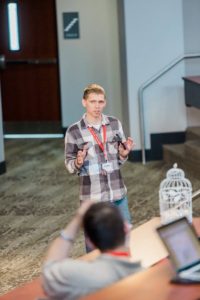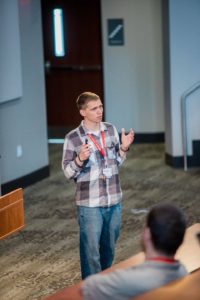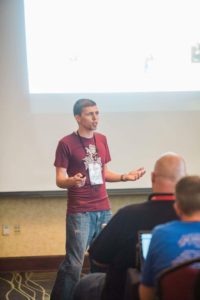This past week marked my first full year conference speaking and I’ve learned a lot. I first spoke at Nebraska.Code(2016) and last week was Nebraska.Code(2017). Though I have been happy with the year, I feel last week I started to achieve some of the goals I set out to. It didn’t come naturally though, it was a bit of work.
The following gives you some insight into what a year of conference speaking looked like for me, give you some hope if you have considered speaking yourself and offer some tips I learned along the way.
Getting Started
Anyone who knows me would agree I have spoken plenty before Nebraska.Code(). Like, I talk a lot. Maybe too much. More seriously though I had given many internal talks to mostly familiar faces. I helped start the Agile for Defense meetup and had given small talks to hand fulls of people I didn’t know. I had also given a talk or two at some other meetups and a speech as the best man to my best friend’s wedding. I had experience, but I am nervous every time. My hands would shake and I would try hard to hide it. Those who are close to me could see it, but no one else admitted to noticing. Speaking at a conference was a desire of mine but it didn’t come naturally to me. It was a friend and colleague, Darin Plum, who utilized my love of Zombies to entice me into submitting a talk together to Nebraska.Code(), which got accepted and started my path here.
The First Talk
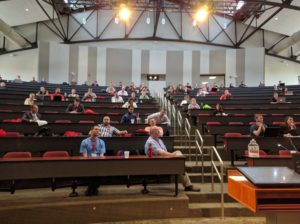 Doing a joint talk helped a lot. Though it comes with its own struggles and we were both new to it, it has obvious benefits: half as much to memorize, lots of feedback throughout development, and overall, lots of help! None the less I spent a lot of time preparing. I watched presentations on how to give good presentations… I sold my soul to slide show tools, tools I steered clear of as much as possible to this point. And I practiced. A lot. I took the path of over preparing, a supposed pitfall when it comes to presenting, but it’s how I’ve always done my talks and now was not the time to under prepare. In May of 2016 we presented Danger: Zombie Apocalypse Ahead — How you and your organizations can avoid the inevitable doomsday scenario. It was a big crowd, huge auditorium and my hands shook. We got through it though. Some jokes worked and some jokes didn’t. We had a couple props which were more hassle than they were worth. We got positive feedback and a handful of attendees who seemed excited to take back some of the concepts we presented. It was success enough to continue.
Doing a joint talk helped a lot. Though it comes with its own struggles and we were both new to it, it has obvious benefits: half as much to memorize, lots of feedback throughout development, and overall, lots of help! None the less I spent a lot of time preparing. I watched presentations on how to give good presentations… I sold my soul to slide show tools, tools I steered clear of as much as possible to this point. And I practiced. A lot. I took the path of over preparing, a supposed pitfall when it comes to presenting, but it’s how I’ve always done my talks and now was not the time to under prepare. In May of 2016 we presented Danger: Zombie Apocalypse Ahead — How you and your organizations can avoid the inevitable doomsday scenario. It was a big crowd, huge auditorium and my hands shook. We got through it though. Some jokes worked and some jokes didn’t. We had a couple props which were more hassle than they were worth. We got positive feedback and a handful of attendees who seemed excited to take back some of the concepts we presented. It was success enough to continue.
The Rest of the Year
 From there I asked another friend and colleague, Katherine Andersen, to submit to Heartland Developer Conference. We presented Something’s Rotten in the State of Quality in September. That was an even bigger audience, we wore microphones, the screen was over sized and it went smoothly. I submitted and got accepted for three talks to Prairie.Code() conference for October: the two above and one new one. All joint talks, all accepted. Three talks at one event was potentially too much, but YOLO, lets do this. The second time for each above went well, though smaller audiences for both. The new talk, Stop Iteration Bait and Switch, was the last talk of the last day, barely anyone showed and half the room was falling asleep. It was a pretty harsh end to the conference circuit that year, but that’s not an uncommon circumstance and so I tried to ignore it (which is quite hard).
From there I asked another friend and colleague, Katherine Andersen, to submit to Heartland Developer Conference. We presented Something’s Rotten in the State of Quality in September. That was an even bigger audience, we wore microphones, the screen was over sized and it went smoothly. I submitted and got accepted for three talks to Prairie.Code() conference for October: the two above and one new one. All joint talks, all accepted. Three talks at one event was potentially too much, but YOLO, lets do this. The second time for each above went well, though smaller audiences for both. The new talk, Stop Iteration Bait and Switch, was the last talk of the last day, barely anyone showed and half the room was falling asleep. It was a pretty harsh end to the conference circuit that year, but that’s not an uncommon circumstance and so I tried to ignore it (which is quite hard).
The Importance of Why
Throughout this time I read the book Start with Why and had some great back and forth with colleagues on the subject. I was already familiar with the concept and even wrote my own Why before then. However it had me heavily consider: Why speak at conferences? There were some obvious ones for me: free ticket to the conference, learn from others, and network with others to learn from later. But why actually present? Well, as described in my Updated Why, what I landed on after much contemplation was: “I am presenting and sharing because I believe these ideas could be leveraged by others, allowing for them to apply these ideas on their teams and therefore cause a bigger impact than what I can do individually.” Focusing on this key point, on why I was really doing this, helped me overcome my shakes and start reaching my goals.
My One Year Speaking Anniversary
I submitted two talks to Nebraska.Code(2017) that I had given already but not at Nebraska.Code(). I submitted them individually, not as a joint presentation. Both were accepted. Having just taken on my first solo speaking conference endeavor I had plenty to be nervous about again. However I have seen Nebraska.Code(), I had familiarity with some of the people, how this worked, and I had spoken quite a bit the previous year (for me anyways).
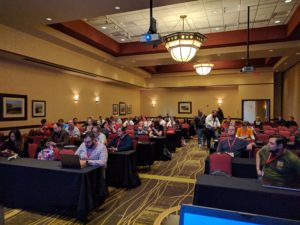 I still over prepared and to be honest, I don’t see myself stopping that habit. I practice my talks for hours. I want most of the words figured out, the points to hit hard and to be on time. I’m open to having some of the words be different each time but the points to be made are important and not left to chance.
I still over prepared and to be honest, I don’t see myself stopping that habit. I practice my talks for hours. I want most of the words figured out, the points to hit hard and to be on time. I’m open to having some of the words be different each time but the points to be made are important and not left to chance.
Something clicked with me this time though. I was honestly excited to share these ideas with the community at the conference with honest hope they could help others make an impact. Don’t get me wrong, I always thought the talks were useful, but I was very caught up in the presenting part, what I would say, how I would say it, and everything else in between. However last week I was very excited. I was going solo, I had quite a few jokes that were risks, some audience participation I had never done before and plenty of reasons to be nervous but for the most part, I wasn’t. I was excited to share and reach people. And that’s exactly what I did. The rooms were full and faces started to become familiar to me. I got tremendously positive feedback from many attendees.
The real wins though were both talks had people telling me of concrete ways they planned on applying the concepts in the coming weeks. This wasn’t just “great talk” feedback, this was starting to accomplish my Why for speaking. It was a very surreal week and very rewarding. It was a ton of hard work and applying skills I’ve been developing for years, slowly, but it truly felt worth it when hearing the plans of those audience members. It was overall a hugely successful week for me.
The Future?
I don’t know what lies ahead for me and speaking. I don’t have a master plan. Kathy and I have been accepted for two talks at the Kansas City Developer Conference (KCDC) in August, one old talk and one new. We are presenting at another meetup nearby and I plan to submit to one more conference for the year. Since I was new to conference speaking I have had lots of ideas to share but I don’t know how sustainable that will be for me year to year. I want to offer useful ideas that could cause real impacts and I’m not sure I discover those big ideas every year. However there are a lot of conferences I haven’t been to, so there is still plenty for me to learn and experience in this realm. Time will tell for where it takes me.
Things I Learned
I want to end with a few tips that I have found valuable throughout the past year:
- Kaizen. Kaizen means take small steps, small improvements, small changes to achieve big things overtime. I applied kaizen in putting together my presentations, the actual slides. In practicing different parts. In trying new things for each presentation. In getting small bits of feedback. In trying new things in networking. We get overwhelmed and paralyzed with too big of a step, no matter what our experience is. So break big ideas, big problems, big todo items into small ones, and take small steps to getting there. The best thing that came from kaizen for me is I never got stuck for long before identifying a smaller step to take and taking action on it. I was always making progress and that helped me be prepared.
- Focus on your audience’s perspective, not the presentation. We waste a lot of time putting a presentation together, focusing on the presentation. We get feedback on how the slides look, on misspellings and a bunch of other things that are pretty irrelevant to the goal. The real question is: what is the audience taking away? A colleague of mine and coach, Andrew Wirick, highlighted the importance of identifying the lens you want the presentation to be viewed from. Who am I trying to reach? Someone new to the concept? Someone who has experienced problems applying a concept? Someone trying to do it better? Someone who’s trying to understand a starting point? What lens is my target audience and how can I present the concepts to reach them? It’s not about our presentation, it’s about the audience.
- Identify and target your Why. Going into 2017 I started to define my talk abstracts entirely differently. I started with a topic and I defined my Why on that topic. Why do I want to give this presentation? How does it fit into my Why? This turned a couple topics into what felt like work, into intrinsically motivated goals. Identifying why helps define that lens discussed above, keeps me motivated, allows me to focus on the audience and gives a framework for making decisions that I didn’t have before.
- Funny Photos of You Will Be Taken. Â There’s always a photographer taking photos of the presenters. They always shoot for an action photo. No matter what, you always look funny. Â It’s okay, embrace it, it’s a trophy we all have gotten use to.
See my talks at Past Presentations.
